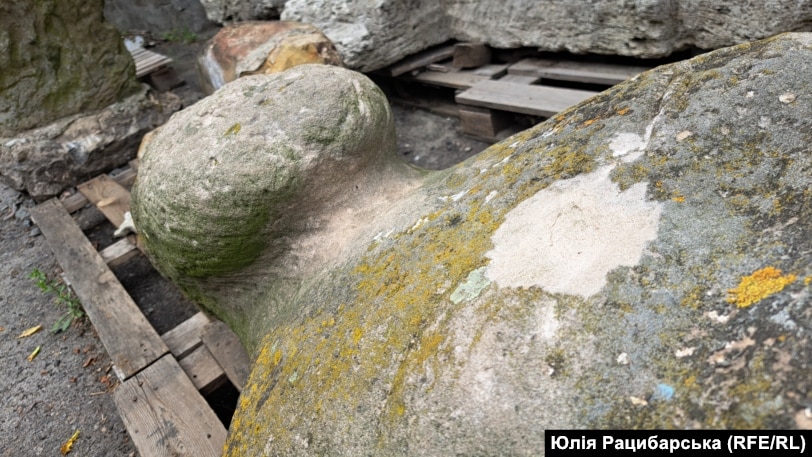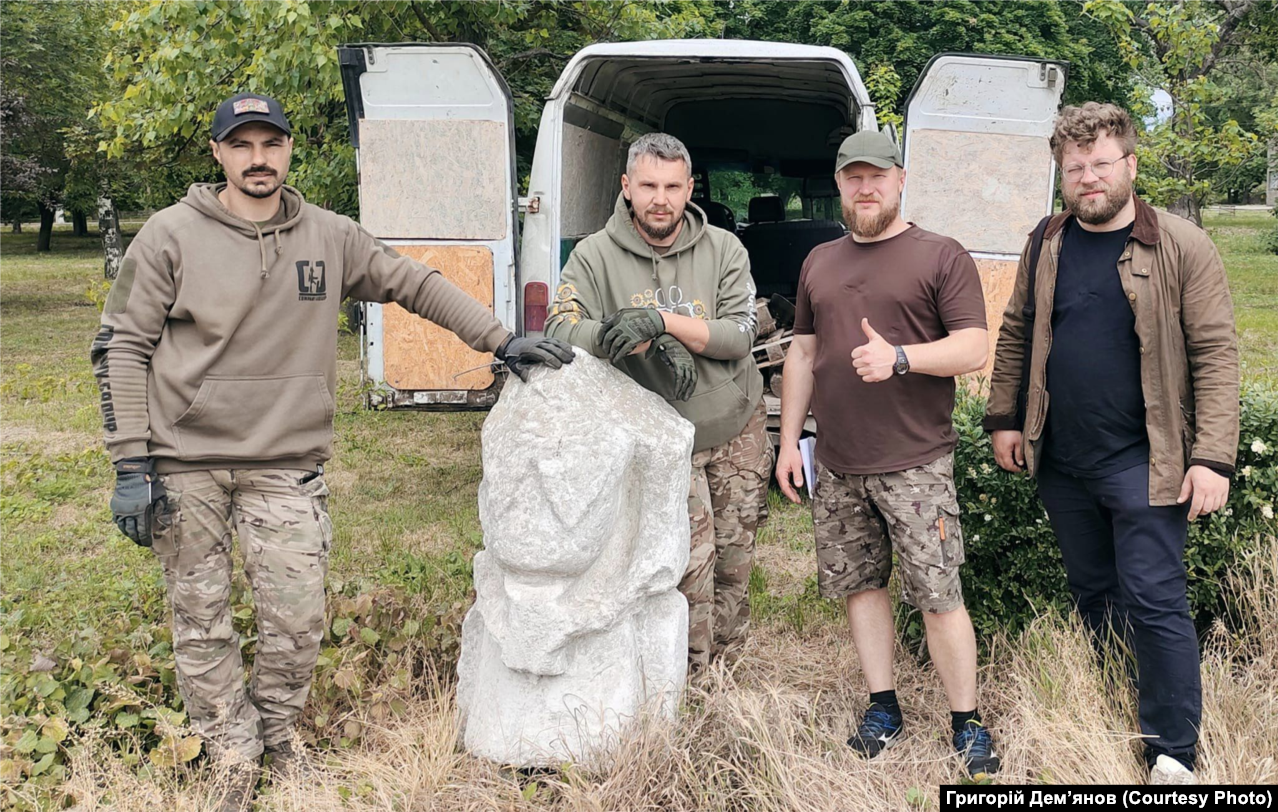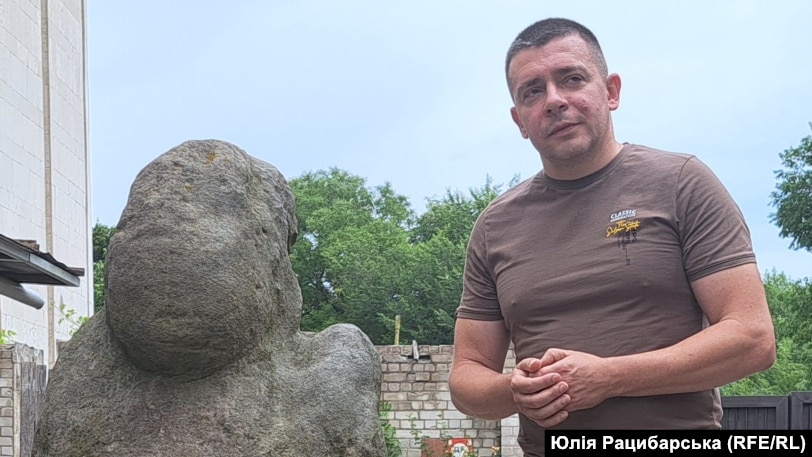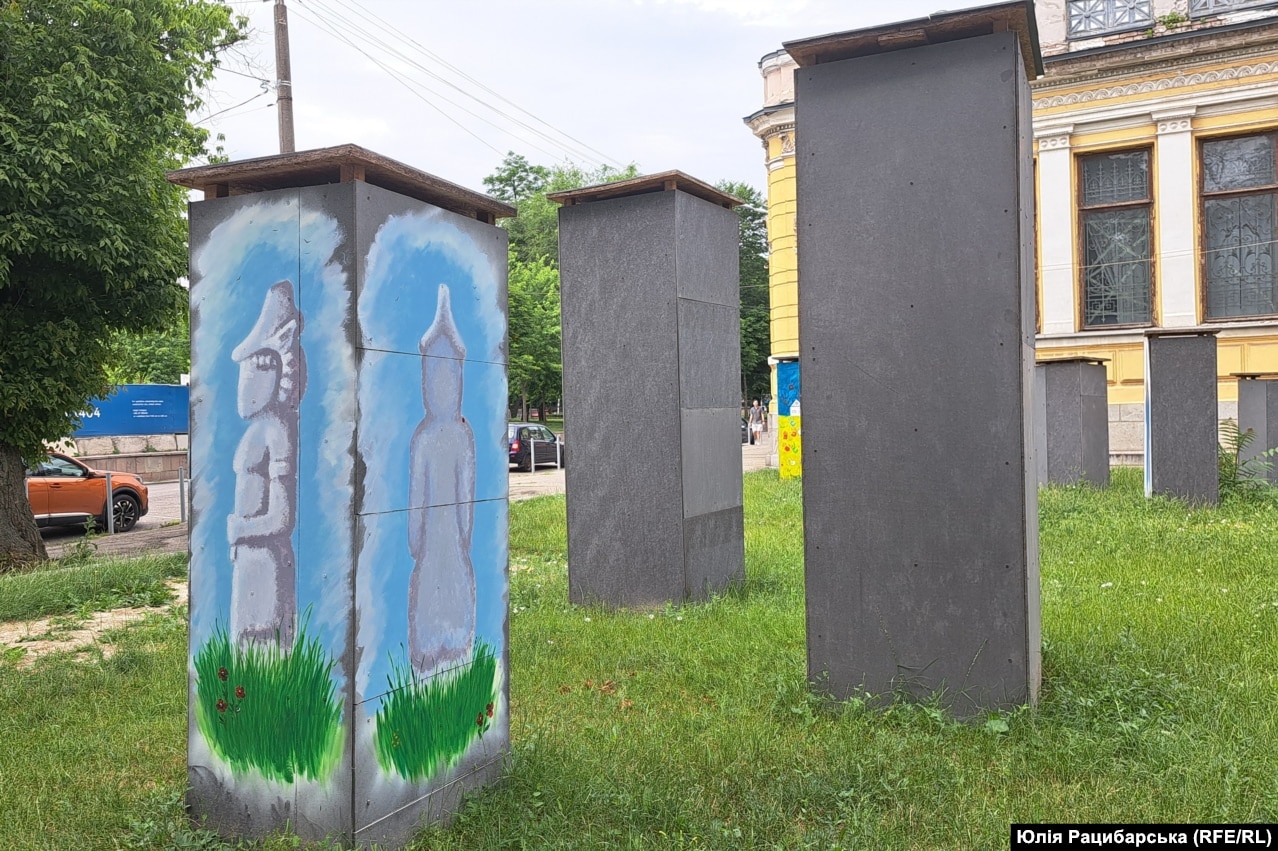Several statues dating from the ninth to the 13th century have been evacuated by volunteers from the front lines amid Russia’s invasion of Ukraine.
A fresh mark on one of Ukraine’s Polovtsian statues is distinct from older injuries. A shard of shrapnel hit almost at the heart of one of the ancient statues.
This is one of the famous Polovtsian figures, estimated to be around 1,000 years old. The monuments were created by a nomadic Turkic group called the Cumans, or Polovtsy, who lived in southern Ukraine.

A stone sculpture bears apparent shrapnel damage.
The shrapnel-scarred Polovtsian statue was evacuated by volunteers from Velika Novosilka, a town in Ukraine’s Donetsk region that today stands just 5 kilometers from Russian positions. The stone monument is one of several that stood in the center of the town and were its calling card until the Russian invasion.
Now Velika Novosilka is half in ruins, says Hryhoriy Demyanov, one of the volunteers who helped to evacuate the monuments.
Since early March 2024, a total nine sculptures have been evacuated to the relative safety of Dnipro. Money for each of the five trips was donated by Ukrainians and foreigners.
“We took out the first two monuments in a car with a trailer. We used crowbars, a winch, and our hands,” Demyanov recalls.

Volunteers pose for a photo during the evacuation of Polovtsian sculptures from the Donetsk region.
For the second evacuation mission, the team prepared better. With heavy equipment they managed to free the third statue relatively quickly. They also found a crane truck and driver who agreed to work in Velika Novosilka.
“The shelling was heavy, a glide bomb flew over the village, and drones were operating — we had to work very quickly,” Demyanov says.
Specialized equipment for loading the sculptures could be obtained only once. The other evacuations were made using improvised methods.
“First, a wooden pallet was tied to the sculpture, after which she was excavated and carefully laid back on the already tied pallet, which served as a support,” Demyanov recalls.
“This is a very important historical artifact. There are not many of them left, so they must be saved. This is our history, our identity,” the volunteer stresses.

Stone sculptures in storage in Dnipro
Since their evacuation from the front lines, the Polovtsian statues and several other ancient monuments have been given temporary shelter in Dnipro.
Oleksandr Starik, acting director of the Dnipropetrovsk National Historical Museum, told RFE/RL’s Donbas.Realities that removing such treasures from the battlefield is essential.
“If the enemy captures these territories, he will not need the monuments. Quite the opposite, because they do not fit into the [Russian] historical myths that they plant in the captured territories,” Starik says.
“They say these territories originally belonged to them, that they were Slavic territories associated with their version of Russia. The nomadic people here, the Polovtsy people, do not fit in with their myths.”

Oleksandr Starik
Starik takes me on an impromptu tour of the site where the Polovtsian statues are currently stored. They once stood atop mounds visible from afar and served as markers in the steppe showing the boundaries of different tribes.
“Each of them is individual. Each one is unique. Clothes, hands under the stomach, bowls in their hands, small legs — all these features are characteristic of Polovtsian sculptures,” the historian says. He believes sacrifices were made at the sites where the groups of statues stood.
The statues may have been treated as living ancestors. “They were seen as alive, and could be communicated with,” Starik says. In some cases they appear to have been punished. Some of the statues were buried face down.

Stone sculptures from the collection of the historical museum in Dnipro stand enclosed in protective boxes.
Starik says a restoration of the evacuated sculptures will be needed, but for now they are simply being held in storage and inspected by experts.
“We are currently working with specialists who are engaged in petrographic analysis of the sculptures, where the materials come from, etc.,” Starik says.
The Historical Museum in Dnipro has the largest collection of ancient stone figures in Ukraine, with 104 in total. Sculptures evacuated from the front lines of the Donetsk region are not counted in that total as they are categorized as being in temporary storage.
If the territory they stood on can be returned to full Ukrainian control, the monuments will be returned to the places they once stood.
News
The Hanging Temple: China’s 1,500-Year-Old Cliffside Marvel of Faith and Engineering
The Hanging Temple: China’s 1,500-Year-Old Cliffside Marvel of Faith and Engineering Perched precariously on the cliffs of Mount Heng in Shanxi Province, China, the Hanging Temple, also known as Xuankong Temple, Hengshan Hanging Temple, or Hanging Monastery, is an architectural…
The Willendorf Venus: A 30,000-Year-Old Masterpiece Reveals Astonishing Secrets
The Willendorf Venus: A 30,000-Year-Old Masterpiece Reveals Astonishing Secrets The “Willendorf Venus” stands as one of the most revered archaeological treasures from the Upper Paleolithic era. Discovered in 1908 by scientist Johann Veran near Willendorf, Austria, this small yet profound…
Unveiling the Maya: Hallucinogens and Rituals Beneath the Yucatán Ball Courts
Unveiling the Maya: Hallucinogens and Rituals Beneath the Yucatán Ball Courts New archaeological research has uncovered intriguing insights into the ritual practices of the ancient Maya civilization. The focus of this study is a ceremonial offering found beneath the sediment…
Uncovering the Oldest Agricultural Machine: The Threshing Sledge’s Neolithic Origins
Uncovering the Oldest Agricultural Machine: The Threshing Sledge’s Neolithic Origins The history of agricultural innovation is a fascinating journey that spans thousands of years, and one of the earliest known agricultural machines is the threshing sledge. Recently, a groundbreaking study…
Nara’s Ancient Sword: A 1,600-Year-Old Protector Against Evil Spirits
Nara’s Ancient Sword: A 1,600-Year-Old Protector Against Evil Spirits In a remarkable discovery that has captured the attention of archaeologists and historians alike, a 7.5-foot-long iron sword was unearthed from a 1,600-year-old burial mound in Nara, Japan. This oversized weapon,…
The Inflatable Plane, Dropped Behind the Lines for Downed Pilots
Experimental The Inflatable Plane, Dropped Behind the Lines for Downed Pilots The Inflatoplane from Goodyear was an unconventional aircraft developed by the Goodyear Aircraft Company, a branch of the renowned Goodyear Tire and Rubber Company, also famed for the Goodyear…
End of content
No more pages to load











